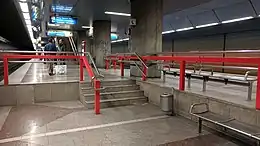Premetro
A premetro is a tramway or light railway which includes segments built to rapid transit standards, generally as part of a process of conversion to a metro-standards railway usually by the construction of tunnels in the central city area.[1][2][3]
.jpg.webp)

History
The first city to carry a portion of a streetcar line through the city center in a tunnel was Marseille, France, in 1893, with its Noailles subterranean station (see Marseille tramway). It was initially operated by horse-drawn wagons. The next prominent example was the Tremont Street subway (1897) in Boston, today part of the MBTA Green Line. These early tunnels were intended solely to reduce streetcar congestion on surface streets, not for later conversion to metro service.[4] Several early streetcar tunnels, including the Steinway Tunnel and East Boston Tunnel, were later converted to metro operation. However, the small loading gauge, tight curves, and steep grades of the streetcar tunnels required smaller metro cars than otherwise desirable.[4]
Second generation
The modern premetro concept Stadtbahn began in 1960s Germany, as rising traffic congestion due to auto ownership led to the construction of new transit systems. Rather than building costly metro lines immediately, some cities built only the downtown tunnels. They could be used by existing tram lines in the short term, with the intention of full metro conversion later - hence "pre-metro".[5] The idea spread to other European countries in the 1970s, especially Belgium, where such systems were explicitly named premetros.[5]
Examples
References
- De Leuw, Cather & Company (1976). Light Rail Transit: A State of the Art Review, Executive Summary. p. 47. Retrieved 30 August 2023.
This step-by-step planning approach to building rail rapid transit is known as pre-metro, implying the intention to ultimately construct a fully grade separated route to be used by rail rapid transit or metro trains.
- Vuchic, Vukan R. (2007). Urban transit systems and technology. Hoboken, N.J: J. Wiley & Sons. p. 580. ISBN 9780471758235. Retrieved 7 October 2023.
PREMETRO—An LRT system designed with provisions for easy conversion into RRT (metro).
- John Hoyle (16 May 1975). "Letters to the editor -- The tram is the answer". Sydney Morning Herald. Retrieved 13 January 2014.
Cities such as Frankfurt and Cologne in West Germany have further developed their tramway system by introducing a concept known as "premetro." In this system trams or light rail vehicles make extensive use of tunnels, reserve track and by utilizing folding steps these vehicles can operate through high or low stopping places.
- Cudahy, Brian J. (1972). Change at Park Street Under. Stephen Greene Press. pp. 10-11, 31-33. ISBN 0828901732. LCCN 72081531.
- Ian Yearsley (21 December 1972). "Trams are coming back". New Scientist. Reed Business Information Ltd. Retrieved 14 January 2014.
But instead of building the entire expensive systems immediately, the Germans hit on the idea of building only the city centre tunnels at first. Intended in the long run to be extended to full undergrounds, in the short term they could be used by trams which would continue to run on the surface outside city centres. The idea spread to other European countries, especially Belgium, where it became known as pre-metro. Today Brussels, Frankfurt, Stuttgart and many other cities are filling their central business districts with construction sites to move the trains underground.
- "Antwerpen Tram & Premetro". UrbanRail.net. 2013. Retrieved 22 January 2014.
Antwerpen rail network is a typical premetro network.
- Geoffroy Fabre (19 March 2014). "Une station fantôme au secours du futur Métro Nord de la STIB". RTBF. Retrieved 9 May 2014.
- "Charleroi Premetro". UrbanRail.net. 2013. Retrieved 22 January 2014.
The Charleroi Metro is a typical prémétro network, i.e. trams that run underground in the city centre and on viaducts or separate right-of-way through outer parts (similar to German Stadtbahn systems).